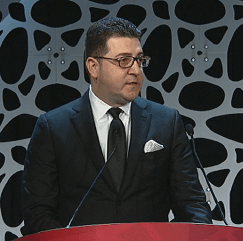
An international clinical study has found that patients experiencing a ‘large’ stroke—characterised by a greater infarct-core volume on imaging—had a dramatically better recovery after receiving an endovascular mechanical thrombectomy plus standard medical management than those who received standard medical management only.
The SELECT2 study, which involved 31 medical centres in North America, Europe, Australia, and New Zealand, was stopped early because of the successful results seen in patients who received thrombectomy treatments for their large vessel occlusion (LVO) strokes.
Amrou Sarraj (Case Western Reserve University, Cleveland, USA), the global principal investigator for the study who presented these first-time data at the 2023 International Stroke Conference (ISC; 8–10 February, Dallas, USA), said: “We went on to challenge the current practice, where patients with large strokes would be precluded from thrombectomy.”
While thrombectomy has proven effective in ‘smaller’ strokes, patients with large cores—leading to an increased range of damaged brain tissue seen on computed tomography (CT) or magnetic resonance imaging (MRI)—have previously been considered too high risk for the procedure.
“These patients are left to receive medical management only, and a significant number of them end up with very poor outcomes; being wheelchair bound, bed ridden, or dead,” said Sarraj. “This is a huge opportunity for improvement at a very large level, especially since these patients account for 20–25% of all large vessel occlusions, and may have a huge impact on patients, their family, and society.”
SELECT2 had a target of 560 patients with LVO causing a large stroke on CT or advanced imaging, but the data and safety monitoring board stopped the trial after enrolment of 352 patients because of the superior outcomes seen with thrombectomy.
In the trial, patients were randomly assigned to receive thrombectomy plus medical management (n=178) or medical management alone (n=174). Patients who were seen prior to 4.5 hours from the onset of stroke received intravenous thrombolysis with alteplase or tenecteplase, if eligible.
“We found that almost 20% of the patients who received a thrombectomy ended up with functional independence, going back to their family, to society, as almost normal or not needing support, compared to 7% for medical treatment only,” Sarraj added. “We also found that almost 40% of the patients end up ambulating independently. This is a huge improvement in these patients with large strokes who are not being offered the treatment [thrombectomy] at this point.”
Sarraj also said he expects the results to change treatment guidelines in the near future—and that “this will give a large number of patients the opportunity for a chance for improvement”.
In his ISC presentation, Sarraj stated that, when considered in conjunction with data from the RESCUE-Japan LIMIT trial, which were presented at last year’s International Stroke Conference, and ANGEL-ASPECT findings, which were also delivered for the first time at ISC 2023, the SELECT2 results “unequivocally demonstrate” the benefits of endovascular thrombectomy in patients with a large ischaemic core.
On 10 February, SELECT2 data were published in the New England Journal of Medicine (NEJM), coinciding with Sarraj’s presentation in Dallas.













